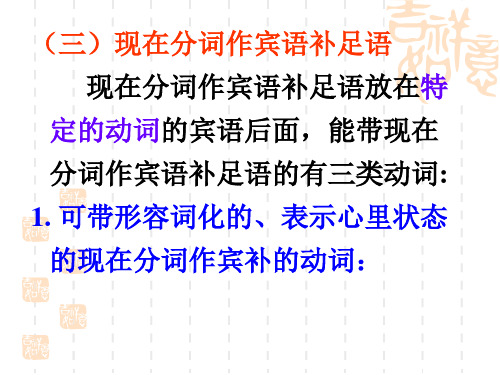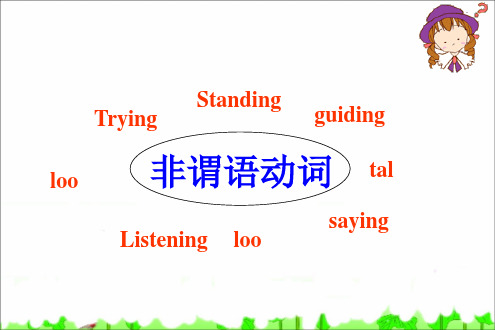现在分词作状语 PPT
合集下载
高中英语 语法 现在分词作状语(共31张PPT)

他句子成份。
需要注意的事项
1. V-ing 形式
V-ing 形式由 “do+ing” 构成, V-ing 可以带宾语或状 语构成 V-ing 短语, 没有人称和数的变化, 但有时态 和语态的变化。
否定形式: not doing 语态:主动或被动 时态:当分词的动作完成以后,主句的动作才发生时,
用现在分词的完成形式作状语。
The person _t_r_a_n_s_la_t_in_g_t_h_e_s_o_n_g_s_can speak seven languages.
3. The boy standing there is reading a book about body language.
The boy _w_h_o_ _is_ _s_t_a_n_d_in_g_ there is reading a book about body language. 4. Because he comes from Jordan, he moves close to ask you a question.
is my father. 定语
When meeting guests, he often felt uneasy.
表时间
Not knowing her telephone number, I didn’t
phone her.
表原因
Turning to the left, you’ll see a school.
When leaving the station, he waved again and again to me.
3. 现在分词作状语时,有时可以在分词前加 once, although, though, until, if 等连词。
需要注意的事项
1. V-ing 形式
V-ing 形式由 “do+ing” 构成, V-ing 可以带宾语或状 语构成 V-ing 短语, 没有人称和数的变化, 但有时态 和语态的变化。
否定形式: not doing 语态:主动或被动 时态:当分词的动作完成以后,主句的动作才发生时,
用现在分词的完成形式作状语。
The person _t_r_a_n_s_la_t_in_g_t_h_e_s_o_n_g_s_can speak seven languages.
3. The boy standing there is reading a book about body language.
The boy _w_h_o_ _is_ _s_t_a_n_d_in_g_ there is reading a book about body language. 4. Because he comes from Jordan, he moves close to ask you a question.
is my father. 定语
When meeting guests, he often felt uneasy.
表时间
Not knowing her telephone number, I didn’t
phone her.
表原因
Turning to the left, you’ll see a school.
When leaving the station, he waved again and again to me.
3. 现在分词作状语时,有时可以在分词前加 once, although, though, until, if 等连词。
现在分词作状语有几种形式有用课件

独立式现在分词作状语
总结词
强调动作的独立性和完整性
详细描述
独立式现在分词作状语时,通常强调动作的独立性和完整性。例如,在句子“Sitting at the table, he started to read his book.”中,“Sitting at the table”是独立式现在分词作状语,强调了他坐 在桌子旁开始读书的动作独立于主句,且具有完整性。
动词不定式作状语
总结词
表达目的、原因等意义,增强句子丰富性
详细描述
动词不定式作状语时,通常表示目的、原因等意义,增强了句子的丰富性。例如 ,在句子“To pass the exam, she spent all night studying.”中,“To pass the exam”是动词不定式作状语,表示她花费一整晚学习是为了通过考试。
要点二
结果
使用现在分词作状语可以表达某个事件或动作发生后的结 果。例如,“他讲了一个笑话,大家都笑了起来。”
04
现在分词作状语与其它结 构区别
与独立主格结构区别
独立主格结构
不能单独使用,需要与主句共用一个主语, 常用于描述伴随状况或补充说明。
现在分词作状语
可以单独使用,表达的动作与主句的主语一 致,通常用于描述原因、方式或伴随状况。
03
现在分词作状语的有用性
表达时间关系
时间名词
使用现在分词作状语可以更清晰地表达某个事件或动作发生 的时间点或时间段。例如,“正在跑步的时候,突然下起了 雨。”
描述先后顺序
使用现在分词作状语可以描述两个或多个事件或动作之间的 先后顺序关系。例如,“完成作业后,我开始准备晚餐。”
描述伴随状况
伴随状况
现在分词作状语(公开课课件)

学习者需求
对于汉语作为第二语言的学习者来说,掌握现在分词作 状语的用法对于提高语言表达的准确性和流利度具有重 要意义。
课程目的
01 知识目标
使学习者了解现在分词作状语的基本概念、用法 和特点。
02 能力目标
通过讲解和练习,使学习者能够正确运用现在分 词作状语,提高语言表达水平。
03 情感目标
培养学习者对汉语语法的兴趣,增强学习汉语的 自信心。
让步状语
表示让步,常用现在分词的一般式。例如
Although raining heavily, they still went out. (尽管雨下得很大,他们还是出去了。)
表示转折的让步,常用现在分词的完成式。例如
Having failed many times, he didn't lose heart. (尽管失败了很多次,他并没有丧失 信心。)
作表语
现在分词作表语时,通常放在系动词 后面,表示主语的特征或状态。如:
The film is very moving.(表语)
作定语
现在分词作定语时,通常放在被修饰 的名词前面,表示主动和进行。如: The rising sun is very beautiful. (定语)
作补足语
现在分词作补足语时,通常放在感官 动词或使役动词后面,表示主动和进 行。如:I heard someone singing in the next room.(补足语)
Given more time, we could have done it better. 如果给我们更多的时 间,我们可以做得更好。
实例三:原因状语
Being ill, he didn't go to school. 他因为生病,所以没有去 上学。
对于汉语作为第二语言的学习者来说,掌握现在分词作 状语的用法对于提高语言表达的准确性和流利度具有重 要意义。
课程目的
01 知识目标
使学习者了解现在分词作状语的基本概念、用法 和特点。
02 能力目标
通过讲解和练习,使学习者能够正确运用现在分 词作状语,提高语言表达水平。
03 情感目标
培养学习者对汉语语法的兴趣,增强学习汉语的 自信心。
让步状语
表示让步,常用现在分词的一般式。例如
Although raining heavily, they still went out. (尽管雨下得很大,他们还是出去了。)
表示转折的让步,常用现在分词的完成式。例如
Having failed many times, he didn't lose heart. (尽管失败了很多次,他并没有丧失 信心。)
作表语
现在分词作表语时,通常放在系动词 后面,表示主语的特征或状态。如:
The film is very moving.(表语)
作定语
现在分词作定语时,通常放在被修饰 的名词前面,表示主动和进行。如: The rising sun is very beautiful. (定语)
作补足语
现在分词作补足语时,通常放在感官 动词或使役动词后面,表示主动和进 行。如:I heard someone singing in the next room.(补足语)
Given more time, we could have done it better. 如果给我们更多的时 间,我们可以做得更好。
实例三:原因状语
Being ill, he didn't go to school. 他因为生病,所以没有去 上学。
分词作状语(共24张PPT)

详细描述
这道练习题将提供一些含有分词作状语的错误句子,要求 学生识别并纠正错误,提高对分词作状语用法的敏感度和 准确性。
总结词
理解分词作状语在复杂句型中的作用
详细描述
这道练习题将通过一些复杂句型,让学生理解分词作状语 在句子中的衔接和修饰作用,以及如何运用分词作状语来 简化复杂句型。
总结词
掌握分词作状语与从句的转换技巧
详细描述
分词短语可以用来描述动作的目的或 意图,例如“为了减肥,我每天早上 跑步。”中的“为了减肥”就是一个 目的状语,表示“我每天早上跑步” 这个动作的目的是减肥。
让步状语
01
让步状语
分词短语表示动作发生的让步条件,通常放在句首或句末 。
02
总结词
表示动作发生的让步条件。
03
详细描述
分词短语可以用来描述动作发生的让步条件,例如“尽管 下雨了,我们还是去了野餐。”中的“尽管下雨了”就是 一个让步状语,表示“我们还是去了野餐”这个动作是在 下雨这个不利条件下发生的。
04
详细描述
这道练习题将重点讲解分词作状语的 时态和语态变化,帮助学生理解不同 时态和语态下分词的使用规则。
06
详细描述
通过这道练习题,学生将进一步提高分词作状 语的运用准确度,避免常见的语法错误,使语 言表达更加规范、准确。
练习题五
总结词
综合运用分词作状语的能力
详细描述
这道练习题将综合考察学生对分词作状语的掌握程度,要求学生在实际语境中灵活运用这一语法点, 提高综合语言运用能力。
总结词
表示动作发生的条件或前提。
详细描述
分词短语可以用来描述动作发生的条件或前提,例如“如果下雨了,我们就不去野餐了。”中的“如果 下雨了”就是一个条件状语,表示“我们就不去野餐了”这个动作发生在下雨这个条件下。
这道练习题将提供一些含有分词作状语的错误句子,要求 学生识别并纠正错误,提高对分词作状语用法的敏感度和 准确性。
总结词
理解分词作状语在复杂句型中的作用
详细描述
这道练习题将通过一些复杂句型,让学生理解分词作状语 在句子中的衔接和修饰作用,以及如何运用分词作状语来 简化复杂句型。
总结词
掌握分词作状语与从句的转换技巧
详细描述
分词短语可以用来描述动作的目的或 意图,例如“为了减肥,我每天早上 跑步。”中的“为了减肥”就是一个 目的状语,表示“我每天早上跑步” 这个动作的目的是减肥。
让步状语
01
让步状语
分词短语表示动作发生的让步条件,通常放在句首或句末 。
02
总结词
表示动作发生的让步条件。
03
详细描述
分词短语可以用来描述动作发生的让步条件,例如“尽管 下雨了,我们还是去了野餐。”中的“尽管下雨了”就是 一个让步状语,表示“我们还是去了野餐”这个动作是在 下雨这个不利条件下发生的。
04
详细描述
这道练习题将重点讲解分词作状语的 时态和语态变化,帮助学生理解不同 时态和语态下分词的使用规则。
06
详细描述
通过这道练习题,学生将进一步提高分词作状 语的运用准确度,避免常见的语法错误,使语 言表达更加规范、准确。
练习题五
总结词
综合运用分词作状语的能力
详细描述
这道练习题将综合考察学生对分词作状语的掌握程度,要求学生在实际语境中灵活运用这一语法点, 提高综合语言运用能力。
总结词
表示动作发生的条件或前提。
详细描述
分词短语可以用来描述动作发生的条件或前提,例如“如果下雨了,我们就不去野餐了。”中的“如果 下雨了”就是一个条件状语,表示“我们就不去野餐了”这个动作发生在下雨这个条件下。
现在分词作伴随状语ppt

eg.
伴随
Accompany
1. He died doing what made him happiest.
2. He laughed looking at the funny boy.
3. Tony came into the room, singing and dancing.
Let's do some exercise.
现在分词作状语
The Present Participle as Adverbial
Group 6 Producer: Zhang Xin现添加在题 分词作状语可以表示结果
Rusult
原因
Cause
时间
Time
条件 让步 添加
Condition Concessi标on方题 式
Manner
或
伴随
Accompany
伴随状语首先是一种状语,用来修饰 动词的,
同时是表示与谓语动词同时进行, 即伴随着谓语动词的动作同时进行。
eg.
伴随
Accompany
He said it angrily pointing
at the notice on the wall.
这里,point与said同时进行,因此, pointing在这里是现在分词作伴随 状语,表示主动和正在进行。
books.
6.He lay on the grass, _s_ta_r_i_n_g (stare) at the sky
for a time.
7.He sat there _th_i_n_k_in_g_ (think), with his head on
his hands. 8.The secretary worked late into the night,
非谓语动词之分词作状语(公开课课件)PPT课件

分词短语作时间状语
表示分词的动作与句子主语的动作在 时间上有先后关系,如“Having finished his work, he went home.”
04
分词作状语的注意事项
分词作状语与从句的区别
分词作状语通常表示伴随、时 间、条件等关系,而从句则可 以表达更复杂的关系和意义。
分词作状语不具有主语和谓语, 而从句有主语和谓语。
详细描述
分词作状语通常紧跟在主语之后 ,表示主语执行的动作或状态的 方式、时间、条件、原因等,是 对主语动作或状态的补充说明。
分词作状语的种类
总结词
分词作状语可以分为现在分词作状语和过去分词作状语两种 。
详细描述
现在分词表示主语正在进行的动作或存在的状态,而过去分 词则表示主语已经完成的动作或存在的状态。
非谓语动词的用法
用作主语
例如,To learn English is important.(学习英 语很重要。)
用作宾语
例如,I like reading books.(我 喜欢读书。)
用作表语
例如,The problem is to find a solution.(问题在于 找到一个解决方案。)
分词作状语的特殊用法
分词短语作伴随状语
分词短语作条件状语
表示分词的动作与句子主语的动作同 时发生,如“He left, accompanied by his secretary.”
表示分词的动作与句子主语的动作在 条件上有因果关系,如“Given more time, they could have done better.”
练习一
请将下列句子中的分词转换为适 当的状语从句。
句子
Hearing the news, she jumped with joy.
现在分词作状语市级公开课课件

学生互动环节:提问和答疑
学生提问
在这一环节,我们将鼓励学生提出自己 在学习过程中遇到的问题和困惑,以便 更好地解决他们的疑惑,提高学习效果 。
VS
教师答疑
教师将针对学生们提出的问题进行详细的 解答和指导,帮助学生更好地理解和掌握 现在分词作状语的用法和技巧。
课后作业和自学建议
布置课后作业
为了巩固学生的学习成果,我们将布置与现 在分词作状语相关的课后作业,要求学生在 规定时间内完成并提交。
05
现在分词作状语的实践应 用
现在分词作状语在口语和书面语中的应用
要点一
生动形象
要点二
修饰谓语
在口语中,现在分词作状语可以生动形象地描述动作或状 态,使语言更加生动有趣。例如,“笑着说”比“笑着说 道”更简洁生动。
在书面语中,现在分词作状语可用于修饰谓语,进一步描 述动作的方式或伴随情况,增强语言的准确性。例如,“ 他悄悄地走进了房间”,“悄悄”作为现在分词作状语, 修饰了“走进”。
课程大纲和安排
大纲:本课程将分为 以下几个部分进行讲 解
2. 现在分词作状语的 用法及示例;
1. 现在分词作状语的 概念和分类;
课程大纲和安排
3. 与现在分词作状语相关的注意事项; 4. 练习与巩固。
安排:课程总时长为90分钟,具体安排如下
课程大纲和安排
1. 导入(5分钟)
01
简要介绍课程目标和内容;
实例分析
通过分析经典文学作品中的现在分词作状语实例,深 入了解其在文学创作中的独特魅力和表达效果,提升 对现在分词作状语的欣赏和理解能力。例如,钱钟书 《围城》中的“他低头默默走着,心里琢磨着那封信 ”。这里的“低头默默走着”和“琢磨着那封信”都 是现在分词作状语,传神地描绘了主人公的内心状态 和动作。
现在分词作状语有几种形式课件

5
(1)相当于原因状语从句
a. Being ill, she didn’t go to school today.
=As she is ill, …
b. Having seen the film ,he didn’t go to the cinema
with them.
=Because he had seen the
having received D. Having not received
作原因状语
现在分词作原因状语,分词结构中否 定词通常放在现在分词前面。
22
单句改错
1. Having not seen the film, I
can’t tell you what INtohtinhkavoifngit. 2. The men worked for extra hours
2.European football is played in 80 couAntries, ______ it the most popular sport in the worl现d.在分词表结果状语
A. Making make
B. makes
C. made D. to
20
3. “Can’t you read?” Mary sAaid _______ to the notice.
8
(4)表示结果
a. The old man died, leaving nothing but debts.
9
(5)表示条件 If playing all day ,you will waste your valuable time.
10
比较现在分词和过去分词作状语的区别
1. Following the old man, we went upstairs.
(1)相当于原因状语从句
a. Being ill, she didn’t go to school today.
=As she is ill, …
b. Having seen the film ,he didn’t go to the cinema
with them.
=Because he had seen the
having received D. Having not received
作原因状语
现在分词作原因状语,分词结构中否 定词通常放在现在分词前面。
22
单句改错
1. Having not seen the film, I
can’t tell you what INtohtinhkavoifngit. 2. The men worked for extra hours
2.European football is played in 80 couAntries, ______ it the most popular sport in the worl现d.在分词表结果状语
A. Making make
B. makes
C. made D. to
20
3. “Can’t you read?” Mary sAaid _______ to the notice.
8
(4)表示结果
a. The old man died, leaving nothing but debts.
9
(5)表示条件 If playing all day ,you will waste your valuable time.
10
比较现在分词和过去分词作状语的区别
1. Following the old man, we went upstairs.
现在分词做状语讲课市公开课一等奖省赛课微课金奖PPT课件

___T_u_rn__t_o_t_h_e_r_ig_h_t__,and you’ll find the school.
第25页
3. 若状语从句与主句主语不一样时: 1)去连词 2)前面主语留下 3) 动词→分词 e.g.
As it were fine, I went fishing with my father. → ___I_t _b_e_in_g__fi_n_e_, __ I went fishing with …
普通来说 / 严格来说/ 坦率地说/ 就个人而言
judging from/ by 由...判断
considering 考虑到
taking ……into consideration 考虑到
supposing 假如
talking / speaking of providing 假如…… Seeing that…既然…
第20页
补 独立主格结构
在用分词短语作状语时, 它逻辑上主语普通必须与 句子主语一致, 如不一致则要加上它自己逻辑上主 语, 这种结构称为独立主格结构
_S_p_r_in_g__c_o_m_i_n_g_____, the trees turned green. 春天来了 _T_im__e_p_e_r_m_it_t_in_g_, we’ll visit the Great Wall. 时间允许话
第17页
3 否定表示
直接在分词前面加not
1._____ a reply, he decided to write again.
A. Not receiving
B. Receiving not
C. Not having received D. Having not received
第25页
3. 若状语从句与主句主语不一样时: 1)去连词 2)前面主语留下 3) 动词→分词 e.g.
As it were fine, I went fishing with my father. → ___I_t _b_e_in_g__fi_n_e_, __ I went fishing with …
普通来说 / 严格来说/ 坦率地说/ 就个人而言
judging from/ by 由...判断
considering 考虑到
taking ……into consideration 考虑到
supposing 假如
talking / speaking of providing 假如…… Seeing that…既然…
第20页
补 独立主格结构
在用分词短语作状语时, 它逻辑上主语普通必须与 句子主语一致, 如不一致则要加上它自己逻辑上主 语, 这种结构称为独立主格结构
_S_p_r_in_g__c_o_m_i_n_g_____, the trees turned green. 春天来了 _T_im__e_p_e_r_m_it_t_in_g_, we’ll visit the Great Wall. 时间允许话
第17页
3 否定表示
直接在分词前面加not
1._____ a reply, he decided to write again.
A. Not receiving
B. Receiving not
C. Not having received D. Having not received
《现在分词作状语》课件

05
现在分词作状语的练习与巩固
选择题练习
总结词
通过选择题练习,学生可以加深对现在分词作状语的理 解,提高对相关句子的辨识能力。
详细描述
设计一系列关于现在分词作状语的选择题,每个题目提 供四个选项,让学生根据句子语境选择正确的答案。题 目难度可以根据学生实际情况进行调整,从简单到复杂 ,逐步提高难度。
让步状语
总结词
表示动作发生的让步条件
详细描述
现在分词短语用作让步状语时,通常放在句 首或句末,表示某个动作发生的让步条件。 例如,“Despite being tired, he insisted
on finishing the work.”(尽管累了,他 还是坚持完成了事项
详细描述
设计一系列中英文互译的翻译题,让学生将含有现在分 词作状语的英文句子翻译成中文,或者将含有相应中文 句子的英文句子翻译成中文。通过翻译实践,学生可以 更好地掌握现在分词作状语的用法,提高语言水平。同 时,教师还可以根据学生的实际水平,提供不同难度的 翻译题目,以满足不同层次学生的学习需求。
THANKS
条件状语
总结词
表示某个动作发生的条件
详细描述
现在分词短语用作条件状语时,通常放在句首或句末,表示某个动作发生的条件。例如 ,“Hearing the news, they immediately set off to the airport.”(听到消息后,
他们立刻出发去机场。)
伴随状语
总结词
表示动作发生时伴随的情况或结果
《现在分词作状语》 ppt课件
contents
目录
• 现在分词作状语的概述 • 现在分词作状语的形式 • 现在分词作状语的用法 • 现在分词作状语的注意事项 • 现在分词作状语的练习与巩固
Unit 2 现在分词作宾补和状语 课件 高一下学期英语人教版(2019)必修第三册

➢Using your head, you’ll find a good way.
➢Turning to the right, you will find a path leading to his cottage.
4. 表伴随动作(多置于句尾) sit/stand/lie/stay… doing sth. ➢And even as she lay dying, her final
thoughts were for others. ➢Nora stood at the bus stop, waiting for a
bus. ➢Although she was tired, she stayed up
➢ Leave the rice to cook for 20 minutes.
➢ I’ll leave you to decide it.
(5) set sb./sth. doing sth. 开始引起某人/物在做某事
➢His words set me thinking deeply.他的话引起我深思。
(强调动作的全过程结束)
➢ I saw an old man crossing the street. 我当时看见一位老人正在过马路。 (只看见动作片段)
➢ I saw an old man cross the street. 我当时看见一位老人过了马路。 (看见动作的全过程)
➢ — Did you hear the door bell _r_in_g_i_n_g_ (ring)? 门铃在响你听见了吗? —Yes, I did. I heard it __r_in_g_____ (ring) three times. 是的,我听见它响了三下。
➢ I can’t get the car to start. 我不能让车发动起来。
➢Turning to the right, you will find a path leading to his cottage.
4. 表伴随动作(多置于句尾) sit/stand/lie/stay… doing sth. ➢And even as she lay dying, her final
thoughts were for others. ➢Nora stood at the bus stop, waiting for a
bus. ➢Although she was tired, she stayed up
➢ Leave the rice to cook for 20 minutes.
➢ I’ll leave you to decide it.
(5) set sb./sth. doing sth. 开始引起某人/物在做某事
➢His words set me thinking deeply.他的话引起我深思。
(强调动作的全过程结束)
➢ I saw an old man crossing the street. 我当时看见一位老人正在过马路。 (只看见动作片段)
➢ I saw an old man cross the street. 我当时看见一位老人过了马路。 (看见动作的全过程)
➢ — Did you hear the door bell _r_in_g_i_n_g_ (ring)? 门铃在响你听见了吗? —Yes, I did. I heard it __r_in_g_____ (ring) three times. 是的,我听见它响了三下。
➢ I can’t get the car to start. 我不能让车发动起来。
高中英语现在分词作状语课件(共26张PPT)

against the ground. (
)
2.动词-ing分词一般式
1. 尽管知道我住在哪里,但他从没来看过我。 _K_n_o_w__in__g__ where I live, he never comes to
see me . Though he knows where I live, he
never comes to see me. 让步状语从句 2. 因为我不知道她的电话号码,所以不能打给 她。 Because I didn’t know her telephone number,
5. _H__a_v_i_n_g__b_e__e_n__t_a_k_e_n___(take) to the lab, we
were taken to the library.
Grammar work: Filling the blanks with –ing form
1. __W__a_lk_i_n_g_s_t_r_a_ig_h_t_____ (一直往前走) , you will
6.从山上看, 我们发现这湖泊更加漂亮了。
If we see from the hill, we find the lake looks more beautiful.
S__e_e_i_n_g_ _f_ro__m_ _t_h_e_h__il_l___, we find that the lake looks more beautiful. -ing分词作条件状语
• Born in Guangzhou, Alice was the only daughter in her family. ‖When she heard the news about Asian Games, she applied to be the first volunteer in her college. ‖ Her parents supported what she had done, and it made her more confident. ‖ Though she was tired , she still did a very good job. ‖ She was considered as the most excellent volunteer, and then Alice was well-known in the college.
状语的用法(形容词、现在分词、过去分词、动词不定式和独立成分做状语)课件-2022届高三英语一轮复习

动词不定式(to do)作状语
• (1)作目的状语,用in order to或so as to • In oder to improve our English, we need to practice more. • (2)作结果状语,常用结构be enough to(足够的),too...to...(太…而不
• personally speaking 就个人而言
talking/speaking of... (谈及……);
• judging by/from... (根据……判断);
given that... (考虑到……);
Thank you for watching !
ቤተ መጻሕፍቲ ባይዱ
能),only to(意料之外的结果) • He hurried to the bus stop,only to find that the bus had already gone. • 他急匆匆赶到车站,结果发现公交车已经走了。
• (3)作原因状语,常与形容词连用,如glad,happy,frightened,surprised等。 • I was frightened to find that in front of my door sat a dog.发现门前坐着
一只狗,我很害怕。
独立成分作状语
• 独立成分作状语(通常位于句首,有逗号隔开),其形式不受前后文的影响。常用 的有:
• considering... (鉴于,考虑到);
supposing that... (假定……);
• generally speaking (总的来说);
providing that... (如果……);
状语的用法
Adverbial
现在分词作状语公开课PPT文档共24页

现在分词作状语公开课
46、法律有权打破平静。——马·格林 47、在一千磅法律里,没有一盎司仁 爱。— —英国
48、法律一多,公正就少。——托·富 勒 49、犯罪总是以惩罚相补偿;只有处 罚才能 使犯罪 得到偿 还。— —达雷 尔
50、弱者比强者更能得到法律的保护 。—— 威·厄尔
56、书不仅是生活,而且是现在、过 去和未 来文化 生活的 源泉。 ——库 法耶夫 57、生命不可能有两次,但许多人连一 次也不 善于度 过。— —吕凯 特 58、问渠哪得清如许,为有源头活水来 。—— 朱熹 59、我的努力求学没有得到别的好处, 只不过 是愈来 愈发觉 自己的 无知。 ——笛 卡儿
拉
60、生活的道路一旦选定,就要勇敢地 走到底 ,决不 回头。 ——左
46、法律有权打破平静。——马·格林 47、在一千磅法律里,没有一盎司仁 爱。— —英国
48、法律一多,公正就少。——托·富 勒 49、犯罪总是以惩罚相补偿;只有处 罚才能 使犯罪 得到偿 还。— —达雷 尔
50、弱者比强者更能得到法律的保护 。—— 威·厄尔
56、书不仅是生活,而且是现在、过 去和未 来文化 生活的 源泉。 ——库 法耶夫 57、生命不可能有两次,但许多人连一 次也不 善于度 过。— —吕凯 特 58、问渠哪得清如许,为有源头活水来 。—— 朱熹 59、我的努力求学没有得到别的好处, 只不过 是愈来 愈发觉 自己的 无知。 ——笛 卡儿
拉
60、生活的道路一旦选定,就要勇敢地 走到底 ,决不 回头。 ——左
- 1、下载文档前请自行甄别文档内容的完整性,平台不提供额外的编辑、内容补充、找答案等附加服务。
- 2、"仅部分预览"的文档,不可在线预览部分如存在完整性等问题,可反馈申请退款(可完整预览的文档不适用该条件!)。
- 3、如文档侵犯您的权益,请联系客服反馈,我们会尽快为您处理(人工客服工作时间:9:00-18:30)。
5. 现在分词作定语表示被修饰名词的动作正在进行或经常发生; 动名词作定语表示被修饰名词的用途。
the sleeping dog (the dog that is sleeping)
the sleeping bag (the bag for sleeping)
6. 过去分词(done)作定语表示与被修饰词是被动关系,分词的动作已完成, 但并不强调先于谓语动作。 切记不可误写作:having been done I can’t find my lost pen.
7.让步状语(Adverbial of concession) (Though) working as hard as he could, hehe –ing Participle as Attributive
I.–ing Participle 作定语的形式: doing
6. 结果状语(Adverbial of result) He did his homework carelessly, making a lot of mistakes.(自然的或必然的结果) 区别:He hurried to the station only to find the train had gone.(意想不到的结果)
*The man who came yesterday comes again. (√)
4. 要表示定语的动作在谓语动作之后发生, 则要用不定式或定语从句表示 将要发生的动作。
*The students to attend the meeting (who will attend the meeting) (参加会议的)will arrive here tomorrow.
2.后置(分词短语做定语时,放在被修饰的名词后): doing, being done
*The children playing outside are in Class Two. *Tea, being a universal drink in many countries, is still carefully prepared. *The television being repaired now was bought ten years ago. *Most of the people working in the factory are young people.
Revision of –ing participle as Adverbial
I.-ing participle作状语时的形式:
主动语态
一般式
doing
完成式
having done
完成进行式 having been doing
被动语态
being done having been done
II. -ing 分词作状语(Adverbial)的要点:
归=纳I c:an三’t 种fin非d m谓y语pe动n w词h作ich定is语lo的st.区别:
1. doing/being done
与被修饰词:主动/被动关系 动作特点:正在进行/经常性、习惯性
与被修饰词:被动关系 2. done
动作特点:已完成的状态
3. to do/to be done
与被修饰词:主动/被动关系 动作特点:尚未发生/即将发生
1.前置(单个分词做定语时,一般放在被修饰的名词前): *The swimming boy is my brother.
注意:有些分词已经形容词化。 试区别:
moving 感人的 inspiring 鼓舞人心的 disappointing 令人失望的
moved 受感动的 inspired 受鼓舞的
结束
disappointed 感到失望的
a frightening voice a frightened voice
令人害怕的语调 从语调中听出说话人感到害怕
记一记: English-speaking countries, a paper-making machine, spoken English,…
4. 原因状语(Adverbial of cause ) Having failed twice, he didn’t want to try again.
5. 条件状语 ( Adverbial of condition) Turning to the right, you will find a path.
2.时间状语(Adverbial of time)
Having finished the homework/After finishing the homework,he turned on the TV. When/While climbing the mountain, he broke his glasses. 3.方式状语(Adverbial of way ) He came running into the classroom.
*Where is the old woman selling eggs? =Where is the old woman who sells eggs? 2. 如果一个分词既要表达进行意义,又要表达被动意义,则用-ing的被动式: being done The question being discussed is important. =The question that is being discussed is important.
a. 如果定语既要表示尚未发生的/将来的动作又要表示被动意义, 则用 不定式的被动式: to be done
You are welcome to the party to be given in our class.
b. 不定式作定语时,与修饰词一般有逻辑上的动宾关系或主谓关系:
I have a lot of words to say.
II.-ing分词作定语时与谓语动词的时间关系:
1. –ing 分词所表示的动作与谓语动词所表示的动作同时发生。
*正在发生的动作: The man running over there is our chairman. =The man who is running over there is our chairman. *经常性、习惯性的动作:
3. 如果分词要表示动作是主动的,又在谓语动作之前发生,则要用定语从句表 (完示成。式having done/having been done不可做限制定语) *The man coming yesterday comes again. (×) *The man having come yesterday comes again. (×)
1.分词的逻辑主语与主句的主语一致。
2.分词短语作状语时,有时前面可带一个连词,表示强调或出于表达需要,常用
的连词有:when, while, if, (al)though, whether, or, unless, as if/though等。
1.伴随状语(Adverbial of attending circumstances) They came in, singing and laughing.
